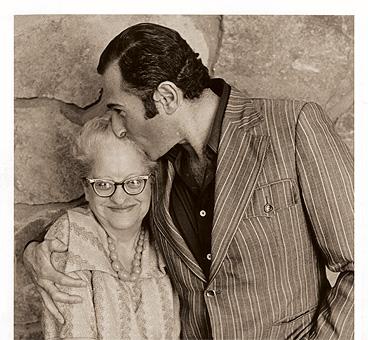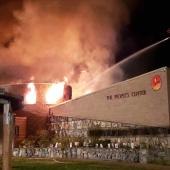Dorothy M. Johnson's Recycled Cinema

When Dorothy M. Johnson attended Saturday movie matinees during the fifteen years she lived in New York City, they provided her with more than just an afternoon’s entertainment. They also sparked some of her most successful stories.“All a writer needs is a jumping-off place,” she said.
In the 1940s and early ‘50s, a double feature always included at least one Western, usually depicting Hollywood’s version of what Johnson claimed as her West—anywhere west of the Mississippi up to the 1890s: the frontier on which she set the majority of her stories.
She often commented that she preferred the 19th century to the 20th, because, she noted, “We know how it came out.” Johnson had been an Air Raid Warden in New York during WWII and had a bomb shelter in her home in Missoula during the tense years of the Cold War, so she understood the 20th century threats to her security and that of the country.

After growing up in Whitefish and graduating from Montana State University in Missoula in 1928, she worked for a while in Washington state and then moved to New York to work first for the Gregg Shorthand Company and then as editor of The Woman magazine. But despite her good jobs and her blossoming career as an author, she was not happy living away from Montana. “For fourteen of those years, I just hated it,” she said of her time in the east.
She coped with her homesickness by reading a lot of western history and seeing western movies. Some of her best plot ideas came from “doing a switch” on a conventional situation she had seen on screen, such as a shootout on the main street of a frontier town.
“The switch is a very important technique for fiction writers,” she often said. “One starts out with a very trite situation and then tries a change in maybe one element to see what difference it will make. That’s where The Man Who Shot Liberty Valance came from. I thought, now what if one of these big bold gunmen who are having a traditional walk down is not fearless—and what if he can’t even shoot? Then what have you got?’
What she had was a story that came back to the screen starring James Stewart as the greenhorn gunman, and John Wayne as the cowboy who really shot outlaw Liberty Valance, played at full snarl by Lee Marvin.
Johnson’s good friend and fellow writer, Jack Schaefer, author of Shane, was horrified when he heard that she had sold the movie rights to Liberty Valance. “They’ll ruin it, they’ll ruin it, one of the finest stories in print,” he predicted. But “they”—mainly John Ford, who was often looked upon as a ”master” of the Western film genre—did not “ruin it.” Quite the contrary.
Dr. Walter Metz of Montana State University‘s film program says Liberty Valance “is, with The Searchers, the cornerstone to the American Western,” adding that “ It’s hard to imagine that in a hundred years, The Man Who Shot Liberty Valance would not be one of the films that people still talk about.”
Johnson was pleased with the screen adaptation of her story. In 1970, she told Jim Crane of the Missoulian staff that she had recently seen the film on television. “I hadn’t seen it except once before, and I’d kind of forgotten just what it was about. This time I thought, ‘My, what a good movie!’’’
The Man Who Shot Liberty Valance was the first film to team Wayne and Stewart as co-stars, and it still plays well to television movie audiences. Autographed photos of its stars in their film costumes hung for years in a place of honor in Johnson’s study. The inscription on Wayne’s read, “Dear Dorothy, Have you anyone else you want shot?”
Two other Johnson stories were turned into major motion pictures. The plot of one—The Hanging Tree—grew out of two Western movies which Johnson saw in New York about a week apart.
“Both of them had a group of bearded, dusty, desperate men lost and thirsty in the desert. I thought ‘This is getting monotonous. What if we make a little switch here, and suppose we had a girl lost and thirsty in the desert? Well, how in the devil would she get there? So I had to figure out how she got there. That’s where the idea came from, and then the rest of the story grew very painfully.”
And slowly. Writing The Hanging Tree —which she envisioned as a novel—took ten years, and then she had to pare it back to novelette length to meet the publisher’s demands. Only 39,000 of the original 65,000 words made it into print.
When that “painfully” worked-out story went back to Hollywood to become the film starring fellow Montanan Gary Cooper, Johnson felt that her product was improved by Hollywood’s packaging of it—although she was a little surprised (and a little disappointed) at the location of the filming. She was never on the set when one of “her” movies was made, and she had hoped to have that opportunity with The Hanging Tree. But “Hollywood apparently felt that Washington looked more like Montana than Montana,” she explained, and so the film was shot out of state.
In The Hanging Tree, Cooper’s character is a western doctor with a murky past who is called upon to treat the “Lost Lady,” played by Maria Schell, after her near-fatal experience of being abandoned in the desert following a stagecoach robbery. When she recovers, she sets about making her fortune by staking gold-seekers and making a handsome profit from their labor. She and Doc Frail (and yes, Johnson often named her characters to suggest their flaws or their virtues) spar throughout the film—as screen (and real life) lovers often do—but at the end, when Frail is about to be strung up on the hanging tree, she saves him by scattering her gold among the crowd to divert them from their plan.
She may not have been on hand for the filming of The Hanging Tree, but Johnson was consulted about a worrisome problem having to do with the name of her story. Someone on the producer’s staff called to ask if she’d ever considered a different title. There was some concern that women might be frightened away from a film with a title which suggested bloodshed and violence.
Johnson told the caller her working title had been “Prisoner of Skull Creek”—which was even less acceptable. “I could have heard the gasp all the way from Hollywood even without the phone,” she said with a chuckle. “But I reassured Hollywood. I said that I’d never heard of Gary Cooper scaring away women!”
Her title stayed and was repeated as the name—and the refrain—of the theme song for the film, a piece that Hollis Alpert of the Saturday Review described as “the most raucous theme song yet heard.” Despite, or perhaps because of, that allegation, Johnson pronounced herself well enough pleased with the song to go out and buy two copies of the record—and a phonograph to play them. Another of her stories and film titles turned song, “The Man Who Shot Liberty Valance,” sung by the late Gene Pitney, also received a lot of air time.
When The Hanging Tree premiered in Montana, during the state’s celebration of its 70th year of statehood, Gary Cooper was on hand for the festivities. He and Johnson had dinner together, but she was too excited to eat. The next day, Cooper brought her a pheasant he had bagged on a hunting trip with Ernest Hemingway to make up for the missed meal. She had the wishbone copper-plated and frequently wore it on a chain around her neck.
She was generally pleased by the screenplays based on her stories, in part because of the unexpected, and very flattering, attention the movies brought to her and her work. In an essay she penned for A Century of Montana Journalism, she noted that having a film based on something she had written caused “a noticeable increase in prestige . . . . When a book becomes a movie, even strangers (even teen-agers!) begin to act respectful.”
In the same article, she debunked the idea that having sold a story to Hollywood automatically made her wealthy. “[James Warner] Bellah wrote the screenplay for Liberty Valance. . .he got $8,000; I got $5,000 for the movie rights,” she told Jack Schaefer.
With the possible exception of the seeming inequity of the original idea being worth less than the screenplay treatment, Johnson had few quarrels with Hollywood’s versions of her stories. “The author is supposed to be very much disturbed when his work is made into a film because his art has been prostituted,” she said. “I don’t really feel that way. I think Hollywood improved some of my stories. However, the movie A Man Called Horse was certainly a surprise to me because my Crow Indians were turned into Sioux Indians who had entirely different customs. . . .And there was this bloody scene which really makes the movie. That was supposed to be something they did all the time. If they did, I’ve yet to read about it in any book or any of the works by ethnologists that I have read on the Sioux.”
A Man Called Horse, perhaps the most commercially successful movie made from a Johnson story, spawned a number of sequels, but Johnson’s name was omitted from the credits in those later films—at her request.
“I’m a purist on Indian customs, and I’m not fond of ancient traditions invented for the occasion,” she explained to a friend who had noticed she was not credited for Return of a Man Called Horse.
In Johnson’s prose version of “A Man Called Horse,” the main character is an Easterner who cannot find anyone he considers his “equal.” When he is captured by Crow Indians while traveling in the American West, he becomes a slave, but eventually he falls in love with and marries the daughter of the family he has served. When she dies, he is free to leave, but, having become a worthwhile person through his experiences, he elects to stay to provide for his mother-in-law, who would be left without a hunter in her lodge if he were to go.
Despite the changes made in the film version, the message remained the same: the physical and emotional challenges met and overcome by the character make him a better person. (A Man Called Horse also reflected a familiar Johnson theme—one that formed the basis for Liberty Valance and The Hanging Tree, as well: In all of these films—as in most of Johnson’s work—the main characters are motivated by love, and that love requires some sacrifice from them. “I admire the kind of person who is capable of change and sacrifice,” she said. “And I believe in love.”)
The year after A Man Called Horse was released, the National Cowboy Hall of Fame honored it with the Western Heritage Award for the outstanding Western motion picture of 1970. Even the film’s stars had glowing praise for the finished product—and for the story that inspired it. Dame Judith Anderson, who played the old Indian woman who eventually became the Richard Harris (“Horse”) character’s mother-in-law, told Time magazine “The story is reminiscent of Homer.” Its widespread popularity was also illustrated in a 1984 political campaign in Idaho, where simple blue and white signs urged votes for “A Man Called Horsch.” And Gary Larson used the tagline “Horse! . . .Is there a man called Horse in here?” for a 1987 cartoon showing several cowboys and one horse sitting at the bar in an old western saloon.
Larson was not the only cartoonist to reference Johnson or her work. Montana’s premier cartoonist, and now novelist, Stan Lynde, twice made references to her in his comic strips. In one, Sheriff “Rick O’Shay” is checking a hotel register—and the top entry is “Dorothy M. Johnson, Rattlesnake Gulch,” which was her actual address until the Missoula city fathers changed the street name to Duncan Drive. In another, an old Indian chief is relaxing in his tepee, reading Indian Country by Johnson. (After the success of Horse on film, the title of that collection of stories was changed to A Man Called Horse.)
When the film was first released, there were several protests by Sioux who did not like the portrayal of their ancestors. But despite the controversy—which she actually found quite “exciting”—and her later detachment from the sequels (which she sometimes referred to as “the return of we know who”), she maintained her friendly attitude toward Hollywood.
“When The Hanging Tree was being filmed,” she recalled, “they left out some material that I’d worked very hard on to get it right. And then they made the movie without it, and it came out fine! I told Kay Burnham, to whom the book is dedicated, about it, and she said in a comforting way, ‘Of course Hollywood had lots of competent help, but you had to write the book all by yourself.”
It is true that the task of writing her stories fell to Dorothy M. Johnson—but the inspiration for many of them came from the movie screen, and then they returned there, to make their own place in movie history.
--
Leave a Comment Here
"A collection of amusing tales and anecdotes about villains, murderers, cannibals, plotters and knaves -- among them, Nero, Attila the Hun, the Borgias, Blackbeard, the Marquis de Sade, and a curiously ravenous fellow known as Liver-eating Johnson."
Who can pass THAT up?












- Reply
Permalink